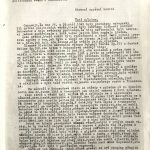Death Transports
In April 1974 the State Security Investigation headquarters in Czechoslovakia opened investigation under Sect. 219 of the Penal Code. The file was registered under No. ČVS-VS-6/110-74. Its purpose was to investigate the tragic incidents in April 1945 when those in so-called death transports in North and West Bohemia found themselves in a hopeless situation, being exhausted, without food and water supplies and severely tortured by their armed escorts.
The investigation file contains copies of reports dated 1945 which indicate that there were numerous death transports and marches. For instance a small township Lubenec, which is situated along the main road between Prague and Karlovy Vary, gave reports of groups of male and female prisoners and prisoners of war in a desperate condition almost every day. The aforementioned investigation file is focused on two death transports – one with prisoners from the Buchenwald concentration camp and from the Ossendorf penal labour camp went along the railway track from Halle area via the North Bohemian region probably to Bavaria and the other from the branches of the Flossenbürg concentration camp in Johanngeorgenstadt (the Krusne Mountains area) and in Zwickau heading towards Terezín. The suffering of exhausted people in the first transport along with the cruelty of the armed escort led to the death of more than 300 people in Bohosudov station. It eventually ended up in Zihle train station, as the main railway junction in Pilsen was out of operation after bombardment. The prisoners from Johanngeorgenstadt probably had to walk on foot for a part of the journey and were reportedly forced into railway wagons near Zihle, while the station was completely overcrowded. The train probably left from Blatno u Jesenice towards Podborany. Only in Zihle and Kastice, more than 500 victims were identified later.
After the end of WWII a special committee was established that tried to identify victims from the mass graves of the death transports and marches. Documents of the committee findings became part of the aforementioned investigation file. The commission was in most of the cases able to identify just the nationality and the prisoner number from the concentration camp where the victims had been kept, but the names – except for two or three cases – are missing. Most of these people came from the Central, South, East or West Europe and we can’t say whether it was later possible to identify more of these victims. If not, their relatives still do not know that they died in these death marches.
In the 1970s some of the living participants of these two death transports as well as some eyewitnesses were questioned; however, it was not possible to find out more about the members of the armed escorts who committed these crimes. The investigation was interrupted in March 1975 and the file was archived under No. V-18044 MV in the former Operative Archives of the Ministry of the Interior.
This is not the only file lodged with the Security Services Archive which deals with the death transports. Another file, for instance, has No. V-18024 MV and is marked as “Death transport 1945 – from the Oswietim concentration camp”. The nature of the archival materials is evidence of the drastic war conflict.









